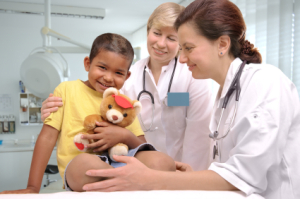by
Brendon Nafziger, DOTmed News Associate Editor | September 18, 2009

Clinical examination may
obviate imaging studies
New guidelines for appropriate use of CT scans on children to determine if a child with head trauma has a serious brain injury could reduce the number of kids exposed to cancer-causing CT radiation, according to a study published in the British medical journal Lancet on Sept. 15.
The doctors say they have identified six risk factors which, when absent, can help predict when a child's head trauma is likely not associated with serious brain damage.
"We evaluated more than 42,000 children of whom approximately 15,000 had CT scans," Nathan Kuppermann, M.D., chairman of the emergency medicine department at UC Davis Children's Hospital, and lead author of the study, tells DOTmed News, "and determined that if certain symptoms weren't present there was a 99.9 percent chance that the child doesn't have a serious brain injury."



Ad Statistics
Times Displayed: 1227
Times Visited: 6 Fast-moving cardiac structures have a big impact on imaging. Fujifilm’s SCENARIA View premium performance CT brings solutions to address motion in Coronary CTA while delivering unique dose saving and workflow increasing benefits.
For children two and over, the risk factors include changed mental status, a history of loss of consciousness, vomiting, signs of a skull fracture or a severe headache. For children younger than two, the risk factors are only slightly different.
Currently, fewer than 10 percent of children who receive CT scans for head trauma have brain injuries revealed by the exam, according to Dr.
Kuppermann.
Dr. Kuppermann thinks if CT scan use on children were more efficient, it could potentially save lives, because children are at greater risk of
developing cancer from CT radiation exposure than adults. They have a longer time for radiation-induced malignancies to develop, he says, and they are more radiosensitive.
And the younger the child, it seems, the greater the risk. Five- to 10-year-olds have a one in 5,000 chance of developing a lethal malignancy from CT radiation exposure, says Dr. Kuppermann. But the risk climbs to one in 1,000 for one-year-olds.
Although CT scans are useful when required, and the dangers are small on an individual level, looking at it from a population perspective means the risk is very real, and a potential public health issue, says Dr. Kuppermann.
"Annually about five to six million kids get CT scans in the United States for all reasons. There are about 600,000 ER visits annually for children for head trauma, with about half getting CT scans," he says. "Run those numbers, you get many children eventually dying" from CT radiation-induced cancers.
Dr. Kuppermann's study was conducted with the Pediatric Emergency Care Applied Research Network (PECARN), a research collaborative involving 25 hospitals.
"This is the largest study on the topic of CT use in head trauma," he says. "With a very large size like this, one can get really good accuracy and precision around the risk of brain injuries given certain clinical findings of head trauma." Or more simply put, "Big sample, precise number," he says.

